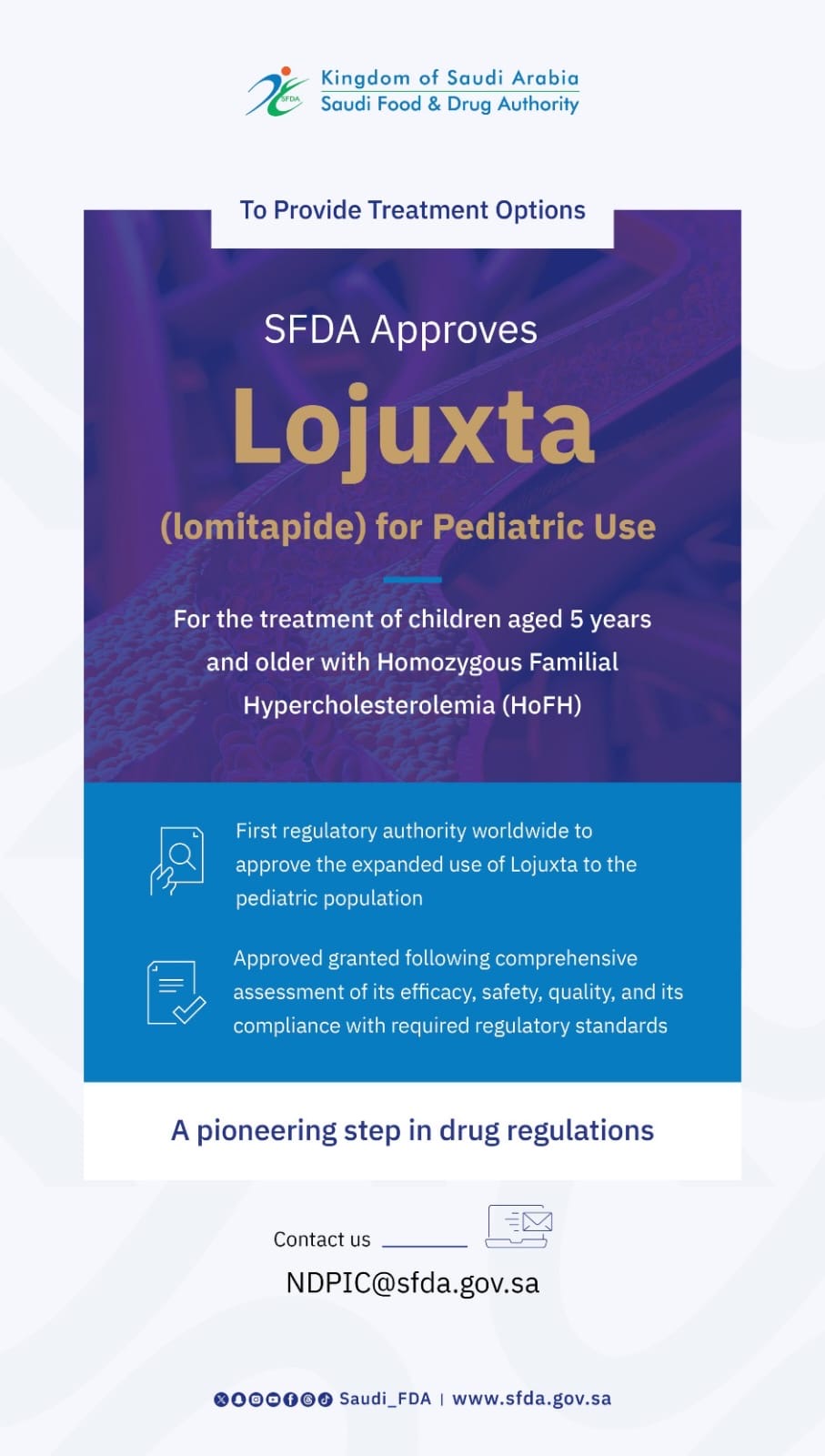MHRA Advises Statin Users
2008-01-12
On January 8, 2008, the Medicines and Healthcare products Regulatory Agency (MHRA), the United Kingdom's equivalent to the Saudi Food and Drug Authority (SFDA), issued an advise for Statin users in the latest issue of Drug Safety Update newsletter.
Statins are effective and widely used treatments for the prevention of cardiovascular events. Consideration of possible drug interactions is important because comorbidity is common in statin users. Interactions may increase the risk of serious adverse reactions (such as myopathy or rhabdomyolysis) or, in some cases, reduce the effectiveness of treatment.
Simvastatin and atorvastatin: interactions
Many important interactions for simvastatin (Zocor) and atorvastatin (Lipitor) relate to drugs that inhibit or induce metabolism via the cytochrome P450 (CYP3A4) enzyme, or that affect transport proteins.
Starting dose
If co-prescription with a drug that increases systemic exposure to statins is unavoidable, it is particularly important to start on the lowest statin dose. For atorvastatin and simvastatin the starting dose is 10 mg daily.
Maintenance doses
The table gives important dose restrictions for atorvastatin and simvastatin when used in combination with other drugs. Both drugs interact with grapefruit juice.
|
Interacting drug or food |
Simvastatin prescribing advice |
Atorvastatin prescribing advice |
|
Potent CYP3A4 inhibitors, including itraconazole, ketoconazole, erythromycin, clarithromycin, telithromycin, and HIV protease inhibitors |
All are contraindicated with simvastatin |
Avoid if possible: consider temporary suspension of atorvastatin if interacting drug is taken for short period Itraconazole: do not exceed 40 mg atorvastatin daily Clarithromycin: do not exceed 20 mg atorvastatin daily HIV protease inhibitors: monitor lipid levels to ensure lowest necessary dose of atorvastatin is used |
|
Ciclosporin* |
Do not exceed 10 mg simvastatin daily |
Do not exceed 10 mg atorvastatin daily |
|
Danazol |
Do not exceed 10 mg simvastatin daily |
No restriction in Summary of Product Characteristics |
|
Verapamil, amiodarone |
Do not exceed 20 mg simvastatin daily |
Monitor lipid levels to ensure lowest necessary dose of atorvastatin is used |
|
Diltiazem |
Do not exceed 40 mg simvastatin daily |
Monitor lipid levels to ensure lowest necessary dose of atorvastatin is used |
|
Grapefruit juice |
Avoid grapefruit juice |
Limit intake of grapefruit juice to very small quantities (or avoid altogether) |
|
Warfarin/courmarins† |
Monitor INR before starting treatment and regularly during treatment, especially with dose changes |
Monitor INR before starting treatment and regularly during treatment, especially with dose changes |
|
Fibrates† |
Increased risk of myopathy when used with fibrates; do not exceed 10 mg simvastatin daily (except with fenofibrate); gemfibrozil increases systemic exposure to simvastatin |
Increased risk of myopathy when used with fibrates; gemfibrozil increases systemic exposure to atorvastatin |
|
Ezetimibe† |
Additive risk of myopathy cannot be ruled out |
Additive risk of myopathy cannot be ruled out |
Medicines that reduce plasma concentrations of simvastatin and atorvastatin
Inducers of CYP3A4 (eg, efavirenz, rifampicin, St John’s wort) may reduce plasma concentrations of simvastatin and atorvastatin. Colestipol reduces plasma levels of atorvastatin, but lipid-lowering effects may be greater than when either drug is given alone. Important interactions to consider with all statins Warfarin/courmarins Statins may affect coumarin anticoagulation and increase the risk of haemorrhagic events. Patients who are receiving warfarin should have INR monitoring before starting statins and regularly throughout treatment, especially with statin dose changes. Caution is particularly necessary with fluvastatin (Lescol), which is metabolised by CYP2C9. However, for pravastatin (Lipostat), which is not metabolised by cytochrome P450, warfarin interaction is less of a concern.
Fibrates
The use of fibrates alone is occasionally associated with myopathy; use with statins may increase this risk. Furthermore, gemfibrozil increases systemic exposure to simvastatin, atorvastatin, and rosuvastatin (Crestor). Careful monitoring is therefore needed, and maximum daily dose of simvastatin is 10 mg daily when used with fibrates (except fenofibrate). For rosuvastatin, start with 5 mg and do not exceed 20 mg during use with fibrates.
Ezetimibe
Ezetimibe has no pharmacokinetic interaction with statins. However, ezetimibe alone is associated with a risk of myopathy and an additive risk with statins cannot be ruled out.
Other important interactions with fluvastatin, pravastatin, and rosuvastatin
Fluvastatin
Caution is needed with ciclosporin, fluconazole, phenytoin, and glibenclamide— see product information for details.
Rosuvastatin
Rosuvastatin is not associated with cytochrome P450 interactions. Ciclosporin is contraindicated with rosuvastatin (Crestor). HIV protease inhibitors strongly increase exposure to rosuvastatin (through an unknown mechanism) and are not recommended for combination use. Antacids reduce rosuvastatin plasma levels.
Pravastatin
Pravastatin is not associated with cytochrome P450 interactions. Caution is needed with ciclosporin, erythromycin, and clarithromycin. Cholestyramine and colestipol decrease plasma levels of pravastatin.
Report Adverse Drug Reactions to the Saudi FDA:
Public and health professionals are encouraged to report adverse drug
reactions to the National Pharmacovigilance Center on the Internet at:





